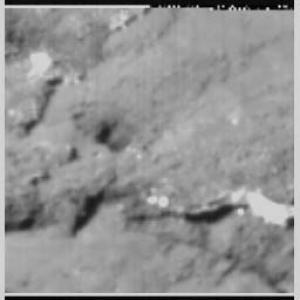Tempel 1, the comet that slammed into the Deep Impact probe on July 4, is three miles wide by seven miles long, and evidently coated with a fine, powdery dust. That dust, says Deep Impact principal investigator Dr. Michael A’Hearn of the University of Maryland, is more like talcum powder than beach sand. “The major surprise was the opacity of the plume the impactor created and the light it gave off,” said A’Hearn, adding “And the surface is definitely not what most people think of when they think of comets — an ice cube.”
 Meanwhile, the immense data recovery and analysis process continues. 4500 images were taken by the spacecraft’s three cameras, with the memory of the impactor’s plunge into the comet’s nucleus still fresh. The final images from the impactor showed surface detail down to the level of four-meter objects, a factor of ten better than any previous comet mission. And we now know that the impactor hit the nucleus at a 25 degree oblique angle relative to the cometary surface, vaporizing the impactor and shooting cometary material outward.
Meanwhile, the immense data recovery and analysis process continues. 4500 images were taken by the spacecraft’s three cameras, with the memory of the impactor’s plunge into the comet’s nucleus still fresh. The final images from the impactor showed surface detail down to the level of four-meter objects, a factor of ten better than any previous comet mission. And we now know that the impactor hit the nucleus at a 25 degree oblique angle relative to the cometary surface, vaporizing the impactor and shooting cometary material outward.
This image of the surface of Tempel 1 (taken by the probe’s impactor targeting sensor) shows the comet about 20 seconds before the collision. This particular region contains the impact site. The bright patches in the image may consist of very smooth and reflective material, the composition of which will be determined by Deep Impact’s spectrometer. Dark areas are in shadow and provide information about surface topography. Higher terrain appears rough relative to lower areas that appear very smooth. Is this a layered surface? And how did the smooth regions form? These are some of the questions the science team plans to address. Image credit: NASA/JPL-Caltech/UMD.
Aboard the flyby spacecraft, all systems seem to be nominal; the craft is now more than 2.2 million miles from Tempel 1 and is undergoing a checkout of its systems. You can continue to follow Deep Impact’s fortunes as more and more data are analyzed at the primary mission site.

